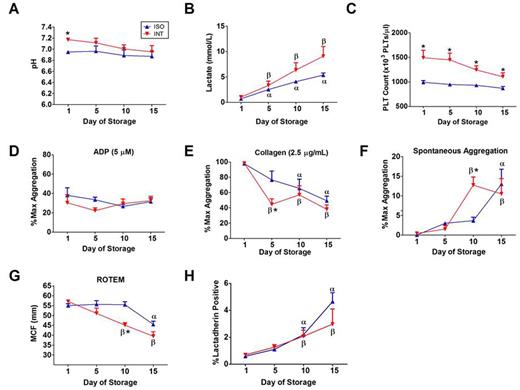Abstract

Platelets (PLTs) are essential for effectively treating severe hemorrhage. While widely considered standard-of-care, storage at room temperature (RT) is limited to 5 days due to bacterial growth risk, loss of function, and increased metabolism. Cold storage (4oC, 4C) slows bacterial growth and better preserves PLT function but also causes increased PLT activation. Storing PLTs in the cold in 65% PLT additive solution (PAS)/35% plasma has been shown to reduce activation and preserve PLT function (Getz, et al. 2016). In the US, only 2 apheresis (AP) and PAS systems are FDA-approved: Trima and Isoplate-PAS (ISO-PAS; Terumo) and Amicus and Intersol-PAS (INT-PAS; Fenwal). Differences in collection processes and PAS composition warrant distinct regulation. The goal of this study was to perform a comprehensive analysis of long-term 4C-stored PLTs collected via FDA-approved AP/PAS methods.
AP PLTs were collected (n=4-5) in 65% ISO-PAS using a Trima (ISO) or in 65% INT-PAS using an Amicus system (INT). All bags were stored for 15 days at 4C without agitation and assayed on Day 1 (baseline, BL), 5, 10, and 15 of storage. PLT count and mean platelet volume (MPV) were obtained using a Coulter counter. Lactate and pH were obtained with i-STAT. All PLT samples were adjusted to a count of 3x105/μl using pooled fresh frozen plasma prior to functional testing. Chrono-Log aggregation was performed with ADP (5 μM), collagen (2.5 μg/ml), TRAP (20 μM), and epinephrine (EPI; 2 μM). Clot strength was evaluated using rotational thromboelastometry (ROTEM). Flow cytometry was used to assess PLT marker abundance (% positive) for CD62P (P-selectin), lactadherin (surface phosphatidylserine [PS]), and CD42b (GPIb). An Amnis ImageStream cytometer was used to visualize PLT mitochondrial depolarization and CD41a expression. Data were reported as means±SEM and analyzed with 1-way ANOVA and student's t-tests for multiple comparisons; significance at p<0.05.
pH (Fig. 1A) was only higher in INT on Day 1 compared to ISO. More lactate production was seen in INT compared to ISO (Fig. 1B). PLT count (Fig. 1C) was significantly higher at all timepoints compared to ISO, no significant differences were observed after 15 days. ISO showed a slight advantage in terms of functional preservation (Fig. 1 D-G). Aggregation response to collagen (Fig. 1E) was preserved in ISO until Day 10, whereas INT showed a significant decrease as early as Day 5 (Day 5: 45±7% vs Day 1: 98±4%; p<.001). Though aggregation response to ADP was similar in both ISO and INT samples (Fig. 1D), increased spontaneous aggregation (Fig. 1F) was exhibited in INT by Day 10 compared to both BL-INT and Day 10-ISO (Day 10-INT: 13±2% vs BL-INT: 0%; p<.001; Day 10-INT vs Day 10-ISO: 4±%; p=0.02). Responses to TRAP and EPI were comparable for ISO and INT. While a significant change in MCF was observed at Day 15 in ISO compared to BL (Day 15: 45.5±1.6, BL: 55±1, p=.002), INT showed a significant decrease in function by Day 10 (Day 10: 45.1±1.3 vs BL: 57.1±0.9; p<.001). PS expression (Fig. 1H) increased at Day 10 in both ISO and INT compared to their respective BL levels.
Producing a hemostatically effective PLT product with an extended shelf-life is of utmost importance due to recent epidemics of viruses such as Chikungunya and Zika and the concomitant increased risk of transfusion-transmitted disease. Storing PLTs at 4C in PAS offers preservation of PLT function for up to 15 days, potentially tripling the current shelf-life of PLT products. We have shown that PLTs collected with Trima in ISO offer better in vitro functional preservation over storage than PLTs collected with Amicus in INT. Implementation of 4C-PAS PLTs may allow for shipment of PLT products to epidemic disease areas and may enhance blood product support for trauma by increasing local inventories and PLT availability in remote locations. Further study and refinement of 4C-stored ISO and INT collection and storage techniques may result in additional improvements in PLT shelf-life and function.
Characterization of PLTs stored for up to 15 days in ISO and INT. (A) pH, (B) Lactate, (C) PLT Count. Aggregation response to (D) ADP and (E) Collagen and (F) Spontaneous Aggregation. ROTEM was performed and (G) MCF was reported. Flow cytometry was used to evaluate PLT activation markers including (H) Lactadherin (surface PS). Data are means±SEM. α p<0.05 vs Day 1-ISO, β p<0.05 vs Day 1-INT, * p<0.05 vs ISO (same day comparison).
Characterization of PLTs stored for up to 15 days in ISO and INT. (A) pH, (B) Lactate, (C) PLT Count. Aggregation response to (D) ADP and (E) Collagen and (F) Spontaneous Aggregation. ROTEM was performed and (G) MCF was reported. Flow cytometry was used to evaluate PLT activation markers including (H) Lactadherin (surface PS). Data are means±SEM. α p<0.05 vs Day 1-ISO, β p<0.05 vs Day 1-INT, * p<0.05 vs ISO (same day comparison).
No relevant conflicts of interest to declare.
Author notes
Asterisk with author names denotes non-ASH members.

This icon denotes a clinically relevant abstract


This feature is available to Subscribers Only
Sign In or Create an Account Close Modal